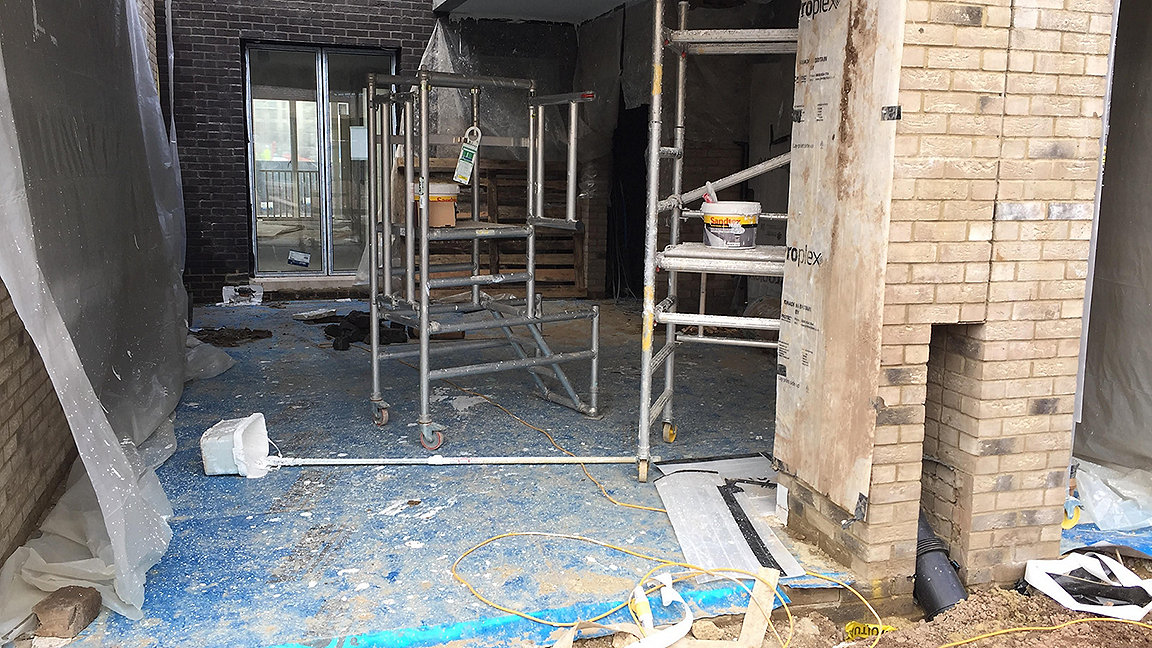
A gas membrane that has been poorly treated by follow-on contractors after installation © MEC Environmental Ltd
The UK has a significant legacy of land contaminated by historic industrial use, mining and waste disposal. Unless adequately addressed, this contamination can still pose unacceptable risks to people and the environment alike.
Although standards in land contamination management have improved significantly over the past two decades, with the Environment Agency recently publishing guidance that identifies the importance of site investigation and risk assessment, the quality of gas protection installation and verification work still varies.
Guidance
Guides such as the Construction Industry Research and Information Association's Good practice on the testing and verification of protection systems for buildings against hazardous ground gases and BS 8485: 2015 + A1: 2019 Code of practice for the design of protective measures for methane and carbon dioxide ground gases for new buildings both actively promote the independent verification of gas protection systems, but the quality of reporting and verification remains frustratingly variable.
If not correctly managed, gas protection can lead to serious incidents; for example, in 2013–14, carbon dioxide seeped from old mine workings into homes in Gorebridge, Midlothian. This caused residents to experience headaches, dry coughs, dizziness and anxiety, and a number of houses subsequently had to be demolished.
As a result of such risks, a number of industry leaders in gas protection verification came together to work with CL:AIRE, a UK environmental charity working in the brownfield land sector, to develop the Gas Protection Verification Accreditation Scheme (GPVS), which was launched in January.
The scheme is designed to help individuals demonstrate their competency in verifying that membranes and other gas protection measures have been correctly installed and tested. More widely, it aims to improve the quality of verification across the industry.
The GPVS will reduce costs associated with protection because it will help prevent the time-consuming repairs arising from poor installation or poor understanding by follow-on contractors. It will also help demonstrate to those suitably qualified as Specialists in Land Condition under the National Quality Mark Scheme (NQMS) that gas protection has been verified by competent personnel.
The scheme is primarily applicable under the planning and building control regimes, although it will be of use wherever it is important to demonstrate competency in verifying gas protection. For example, this may be necessary where properties require protection retrofitting, where potential insurance claims against poor installation work need to be supported, or where planning conditions are not discharged correctly.
Eligibility
Practitioners applying to the scheme are assessed against a series of eligibility criteria and core competencies. Depending on the outcome of their assessments, they can then apply at technician or specialist level. The GPVS application process requires candidates to submit supporting evidence according to the grade of accreditation.
Once candidates demonstrate that they meet the requirements, they will be invited to undertake an assessment and interview. Interviews are carried out by approved assessors who have themselves been assessed against the process.
Successful candidates will be accredited as technician (TGPV) or as specialist (SGPV) according to their application. However, if at their interview they have not evidenced sufficient competency to be an SGPV, they may be awarded the lower grade of TGPV.
The technician accreditation is intended for those in the field who confine their work to inspections. They will not prepare verification design or method statements, although they will follow those prepared by others; neither do they write validation reports, although they do prepare field records that form part of such reports.
The accreditation SGPV meanwhile applies to those involved in the whole range of gas protection verification, including design, method statements, inspections and validation reports. Those awarded SGPV status are invited to join the SGPV register and given a unique badge for identification purposes. This open register records their names, employers, and declarations of compliance.
Quality mark
A report produced by an SGPV under the scheme will always be accompanied by a declaration of compliance, and bear the GPVS quality mark so it can be clearly identified. Each declaration has a unique reference number that is publicly available on the register.
- the work has been carried out to an acceptable standard
- the work has been verified by suitably experienced and qualified personnel
- the level of verification is proportionate to the risk identified in the site investigation report or gas risk assessment
- the interpretations and conclusions are reasonable
- the verification strategy is in line with industry guidance
- they themselves are competent to sign the declaration, and are fully aware of and compliant with the GPVS code of conduct
- the work of the review and the declaration are within the limits of the SGPV's knowledge, competence and professional capacity.
The scheme will support regulators by ensuring there are sufficient competent individuals who can audit and prepare validation reports on gas protection verification in line with industry standards.
It is to be hoped that the brownfield sector and those specifying gas mitigation measures, including surveyors, get behind the GPVS, and only contract independent competent individuals to carry out verification. This will result in a higher standard of gas protection – and thus public safety – across the UK.
Michael Corban is a director at MEC Environmental Ltd and an accredited SGPV
Contact Michael: Email
Related competencies include: Inspection, Legal/regulatory compliance, Risk management
